Can You Use a Construction Loan to Complete Renovations?
Renovations can improve your home and increase its value. But as any seasoned homeowner will tell you, those projects can be expensive. If you can’t afford to cover the costs out of pocket, you may wonder if a construction loan is right for you. While it is an option, there are complications that people should be aware of.
We’ll take a look at construction loans, their requirements, and some alternatives to consider.
Key Points
• Construction loans finance new home builds or major renovations, covering various costs.
• Funds are released in stages, with interest-only payments on received amounts.
• Lenders require a low debt-to-income ratio, high credit score, and a 20% down payment.
• Benefits include covering all construction expenses, flexible terms, and potential savings.
• Alternatives like personal loans and cash-out refinances offer lower interest rates and flexible repayment.
Overview of How Construction Loans Work
Construction loans finance the building of a new home or substantial renovations to a current home. They are typically short-term loans with higher interest rates, designed to cover the costs of land, plans, permits and fees, labor, materials, and closing costs. They can also provide a contingency reserve if construction goes over budget.
With a construction loan for a remodel, applicants must submit project plans and schedules along with their financial information. Once approved, they receive funding for the first phase of building only, rather than a lump sum. As construction progresses, assessments are provided to the lender so that the next round of funds can be released. Meanwhile, borrowers make interest-only payments on the funds they’ve received.
When construction is finished — and the borrower now has a home to serve as collateral — the construction loan may be converted to or paid off by a regular mortgage. The borrower then begins repaying both the principal and interest.
Recommended: Home Maintenance Checklist
Renovation Loans vs. Construction Loans: What’s the Difference?
Though renovation loans and construction loans can be used for similar purposes, there are important differences to know. Let’s take a closer look at both types of loans.
Renovation Loans
Unlike other types of home improvement loans, a renovation loan takes into account the property’s after-repair value, which is an estimation of the home’s value once the improvements are made. This can be good news for borrowers, especially those buying a fixer-upper. That’s because they may be able to secure a larger loan amount than they would with a traditional mortgage based on the home’s current value.
What’s more, renovation loans often come with lower interest rates than credit cards and unsecured personal loans.
Some common types of renovation loans include:
• Government-sponsored loans, such as the FHA 203(k) home loan, Freddie Mac’s CHOICERenovation loan, and Fannie Mae’s HomeStyle renovation loan. Each type has its own rules and requirements.
• A home equity loan
• A home equity line of credit (HELOC)
• VA renovation loans, which are available to eligible veterans and active-duty military personnel.
Construction Loans
As we mentioned, a construction loan is commonly used to pay for building a brand-new home. In some cases, the loan can be converted to a mortgage after your home is finished. However, getting one can be more challenging than securing a conventional mortgage.
Lenders generally want to see a debt-to-income ratio of 45% or lower and a high credit score, and you may be required to make a down payment of at least 20%. Depending on the type of construction loan you apply for, you may also be required to provide a detailed plan, budget, and schedule for the construction. Some lenders will also need to approve your builder.
There are different types of construction loans to consider:
• Construction-to-permanent loans, or single-close loans, which converts to a mortgage once the project is finished. The borrower saves money on closing costs by eliminating a second loan closing.
• Construction-only loans, or standalone construction loans, which must be paid off when the building is complete. You will need to apply for a mortgage if you don’t have the cash to do so.
• Renovation construction loans, which are designed to cover the cost of substantial renovations on an existing home. The loan gets folded into the mortgage once the project is complete.
Awarded Best Online Personal Loan by NerdWallet.
Apply Online, Same Day Funding
Pros and Cons of Using a Renovation Loan
As you explore different home improvement loans, consider the following pros and cons of renovation loans.
Pros
• Borrowers may have access to substantial funds that can pay for major upgrades or repairs.
• Money can be used for a wide variety of renovation projects.
• The loan amount is based on the home’s projected value after the repairs and renovations are complete.
• Interest rates tend to be lower than what you’d be offered with an unsecured loan or credit card.
Cons
• You may be required to use your home as collateral.
• As with any loan, you’ll need to meet certain eligibility requirements, such as a good credit score, low debt-to-income ratio, and proof of income and employment.
• A renovation loan increases your debt load, which could put a strain on your finances.
Recommended: Home Inspection Checklist
Pros and Cons of Using a Construction Loan
There are advantages and disadvantages to consider before taking out a construction loan to fund renovations.
Pros
• Funds can be used to cover all construction expenses.
• Borrowers can use equity from other investments as collateral.
• Loan requirements are generally focused on the construction process instead of a borrower’s credit profile.
• Borrowers may only need to make interest payments during construction.
• Loan terms may be more flexible than a traditional loan.
Cons
• Funds are released as work progresses instead of in one lump sum.
• It can be difficult to find lenders that offer competitive rates and to qualify for them — particularly if you don’t have a flawless credit history.
• Loans tend to be short-term and must be paid in full at the end of the term.
• May need to provide extensive documentation on the construction process in order to get approved.
• If construction is delayed, you may need to ask the lender for an extension on the loan. This can cause interest rates and fees to accumulate.
Alternative Ways to Finance Home Renovations
If you are planning a small construction project or renovation, there are a few financing alternatives that might be easier to access and give you more flexibility.
Personal Loans for Renovations
An unsecured personal loan can fund a renovation project or supplement other construction financing.
Personal loan interest rates are typically lower than construction loan rates, depending on your financial profile. And you can frequently choose a personal loan with a fixed interest rate.
Personal loans also offer potentially better terms. Instead of being required to pay off the loan as soon as the home is finished, you can opt for a longer repayment period. And applying for a personal loan and getting approved can be much faster and easier than for a construction loan.
The drawbacks? You won’t be able to roll your personal loan into a mortgage once your renovation or building project is finished.
And because the loan is disbursed all at once, you will have to parse out the money yourself, instead of depending on the lender to finance the build in stages.
Cash-Out Refinance for Construction Costs
A cash-out refinance is also a good financing tool, particularly if you have a lot of equity in your current home. With a cash-out refinance, you refinance your home for more than you owe and are given the difference in cash.
You can estimate your building or renovation expenses with this Home Improvement Cost Calculator. Add your estimate to what you owe on your home to get the amount of your refinance.
The Takeaway
Planning a new home or substantial renovation? There are several ways to pay for the projects. One option is a renovation loan, which lets you pay for major (and minor) renovations without having to dip into your personal savings. Another option is a construction loan, which typically covers the entirety of new construction expenses. For smaller projects, a personal loan can be a good option — and a lot less complicated.
Think twice before turning to high-interest credit cards. Consider a SoFi personal loan instead. SoFi offers competitive fixed rates and same-day funding. See your rate in minutes.
SoFi Loan Products
SoFi loans are originated by SoFi Bank, N.A., NMLS #696891 (Member FDIC). For additional product-specific legal and licensing information, see SoFi.com/legal. Equal Housing Lender.
Non affiliation: SoFi isn’t affiliated with any of the companies highlighted in this article.
Financial Tips & Strategies: The tips provided on this website are of a general nature and do not take into account your specific objectives, financial situation, and needs. You should always consider their appropriateness given your own circumstances.
SOPL-Q424-060
Read more




